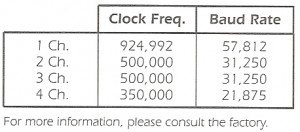53A-431B QUAD UART CARD
ORDERING INFORMATION
53A-431B – Quad UART Card
OPT 03 – External Clock
OPT 1V – Add VXIbus Compatibility
53A-754 – Data Cable or
53A-780 – Hooded Connector
• Supports four transmit and receive channels operating simultaneously at up to 19,200 baud
• External devices may be interfaced using RS-232 or RS-422
• A separate data buffer may be associated with the transmit and/or the receive side of each channel
• Internal self test
The 53A-431B Quad Universal Asynchronous Receiver/Transmitter card allows up to four external devices to interface to the CDSbus™ System utilizing either RS-232 or RS-422 protocol. The Quad UART Card can accommodate transmitting and receiving on all four channels simultaneously at up to 9,600 baud. All of the key protocol parameters for each of the four channels (baud rate. word length, parity checking. and interrupts) are under program control and stored in non-volatile memory Switches are provided to allow the user to select between RS-232 or RS-422, inverting or non-inverting data. and data echo for each channel. In addition. each individual channel can be looped back on itself under program control in order to perform a full self test of the 53A-431B.
A separate data buffer is associated with the transmit side and receive side of each channel. A total of 32 Kilobytes of on-card memory is provided standard. The amount of memory allocated to each channel’s transmitter receive side is programmable from 0 KBytes to the maximum available memory in one KByte increments.
For applications that require baud rates greater than 19,200, Option 03 should be used. This option requires the use of an external clock that is 16 times the desired data rate. The following table shows the maximum data rates achievable versus the number of active channels:

BITE
Built-In-Test Equipment (“BITE”) for the 53A-431B is provided by a series of LEDs that indicate the status of -the various RS-232/ RS-422 parameters such as TXD, RXD, CTS, DCD, DTR, and RTS, as well as channel and link programming errors.
Specifications
Number of Channels:
Four.
Interface Specifications:
EIA RS-232C (1969).
EIA RS-422A (1978).
Modes:
Asynchronous with request-to-send and clear-to-send or XON/XOFF Protocol.
Signal Levels:
RS-422 Transmit, 2V min to 5V max differential (100 Ohm load).
RS-232 Transmit, ±9V min to ± 14V max (3000 Ohm load).
RS-422 Receive. 200 mV min to 30V max differential.
RS-232 Receive, +3V to +30V space (binary OJ, – 30V to OV mark (binary 1)
Logic Levels:
Inverted or non-inverted (switch-selectable).
Data Buffers (each channel):
Transmit 0 to 4 KBytes in 1 KByte increments.
Receive. 0 to 4 KBytes in 1 KByte increments.
Baud Rates (programmable for each channel):
110, 300, 600, 1200, 1800, 2400. 4800, 9600, and 19200 baud.
Word Length (programmable for each channel):
5, 6, 7, or 8 bits with 1, 1.5 or 2 stop bits.
Parity Generation/Checking
(programmable for each channel):
Odd, even, or none.
Error Detection (each channel):
Parity and receive errors.
Interrupt Types (programmable):
Specific character, buffer size, buffer overflow, link error (including parity), XON/XOFF.
Programmed By:
ASCII Characters.
Recommended Cables:
53A-754.
53A-780.
Available Options:
OPT 03, external clock.
OPT 1V. add VXlbus compatibility.